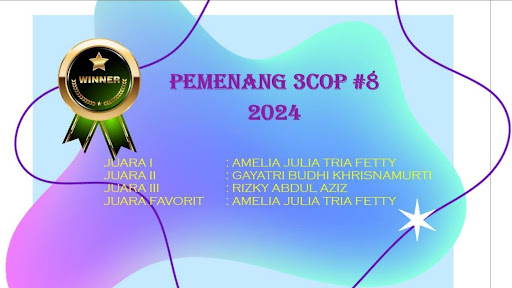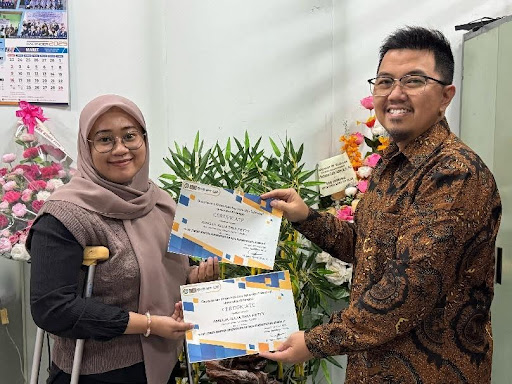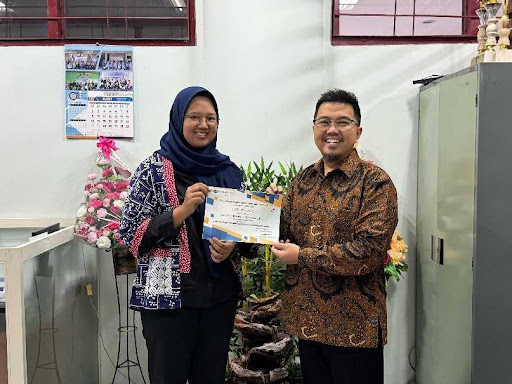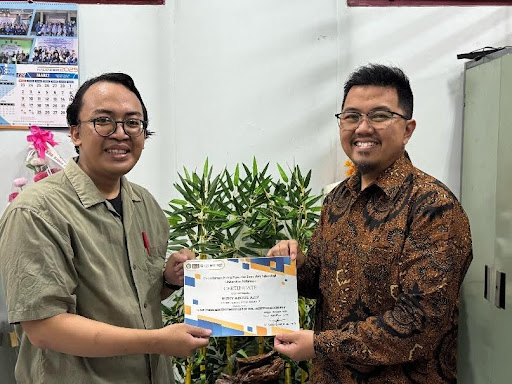Congratulations to the Winners of 3COP #8 2024

The 3COP Competition, or the 3 Minutes Competition on Oral Presentation, is a mandatory contest for master’s students of Chemistry at Airlangga University. Participants present their research proposals in English within 3 minutes. This competition aims to improve communication skills in research and academics. Participants compete for four positions: 1st place, 2nd place, 3rd place, and the favorite award.

In the 8th 3COP competition, the 1st place and favorite awards were both won by Amelia Julia Tria Fetty (Amel), with her research titled “Cellulose Acetate Polymer Membrane for Creatinine Removal in Dialysate Fluid.” Amel is interested in this research topic because reducing water consumption in hemodialysis is an important step toward achieving the United Nations’ Sustainable Development Goals. The optimal solution to this goal is purifying used dialysate fluid, which allows a reduction in the volume of water used during hemodialysis.
Polymer membranes are one alternative method to regenerate used dialysate. Cellulose acetate membranes are one of the polymers widely studied because they are hydrophilic and possess superior characteristics such as good fouling resistance, moderate flux, and good biocompatibility. Cellulose acetate membranes have been extensively used by researchers for dialysate regeneration due to their hydrophilicity. Therefore, in this study, cellulose acetate polymer membranes were used for creatinine removal in dialysate fluid.

The 2nd place was awarded to Gayatri Budhi Khrisnamurti (Gayatri) for her research titled “Effect of Substituents on Benzoquinone Derivatives as Electron Acceptors in the Dehydrogenation Reaction Catalyzed by 3-Ketosteroid-Δ1-Dehydrogenase from Thermomonospora curvata.” Gayatri explained that sterols are a type of lipid with a cyclopentanoperhydrophenanthrene structure that functions to maintain cell membrane stability and serves as a precursor in the synthesis of steroid hormones and vitamin D. Microorganisms can convert natural sterols such as cholesterol and phytosterols into steroid drug precursors through biocatalysis.
The enzyme 3-ketosteroid-Δ1-dehydrogenase (Δ1-KSTD) plays a role in the 1,2-dehydrogenation reaction of 3-ketosteroids, which is crucial in the production of anti-inflammatory drugs such as cortisol and prednisone.
Thermomonospora curvata, a thermophilic bacterium from the Actinobacteria phylum, produces Δ1-KSTD (Tcu-Δ1-KSTD) that has high potential in steroid biotransformation at an optimal temperature of 50–60°C. The natural electron acceptor for Δ1-KSTD has not been identified, but several benzoquinone derivatives, such as chloranil, can serve as alternatives. This enzyme kinetic study on various benzoquinone derivatives is expected to help understand the effect of substituents on the benzoquinone ring’s electron density, which significantly influences the 1,2-dehydrogenation reaction catalyzed by Tcu-Δ1-KSTD.

The 3rd place was awarded to Rizky Abdul Aziz for his research titled “Application of Mixed Matrix Membrane PES/CuFe₂O₄ as a Photocatalytic Membrane for Degradation of the Antibiotic Compound Chloramphenicol.” Rizky said he was interested in this topic because antibiotics are widely used in humans and animals, but their excessive use can contaminate the environment, especially through hospital waste containing antibiotic residues like chloramphenicol. Chloramphenicol is commonly used due to its low cost and high stability; however, its residues in the environment can lead to bacterial resistance and pose risks to human health and the economy, such as export bans on shrimp due to chloramphenicol residues.
Various methods have been developed to remove chloramphenicol from the environment, such as adsorption using composites, MOFs, and carbon-based materials, but each has limitations.
A promising approach is the use of photocatalytic membranes, especially Mixed Matrix Membranes (MMM) based on polyethersulfone (PES) modified with photocatalytic materials like CuFe₂O₄. CuFe₂O₄ ferrite is chosen for its stability, affordability, environmental friendliness, and its ability to enhance membrane performance in degrading chloramphenicol and reducing fouling. This research aims to develop and test PES-CuFe₂O₄-based photocatalytic membranes in flat-sheet form for water treatment, with evaluations including mechanical properties testing, tensile testing, and degradation efficiency of chloramphenicol.
Edited by: Kautsar Ul Haq

